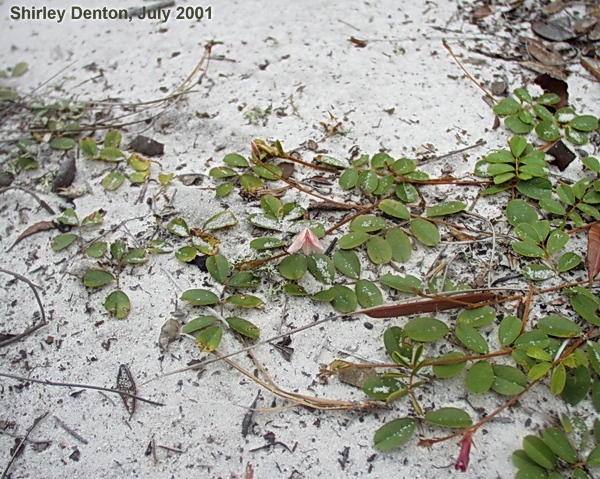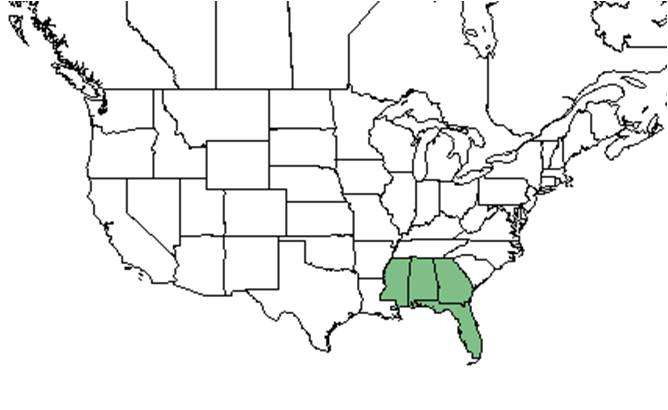Difference between revisions of "Tephrosia chrysophylla"
KatieMccoy (talk | contribs) (→Description) |
KatieMccoy (talk | contribs) (→Distribution) |
||
| Line 25: | Line 25: | ||
==Distribution== | ==Distribution== | ||
| + | Florida, Georgia, Alabama, and Mississippi. Critically imperiled in Georgia<ref name="natureserve">[[http://explorer.natureserve.org/servlet/NatureServe?searchName=Tephrosia+chrysophylla]]NatureServe. Accessed: March 17, 2016</ref>. | ||
| + | |||
==Ecology== | ==Ecology== | ||
===Habitat=== <!--Natural communities, human disturbed habitats, topography, hydrology, soils, light, fire regime requirements for removal of competition, etc.--> | ===Habitat=== <!--Natural communities, human disturbed habitats, topography, hydrology, soils, light, fire regime requirements for removal of competition, etc.--> | ||
Revision as of 19:48, 18 March 2016
| Tephrosia chrysophylla | |
|---|---|

| |
| Photo by Shirley Denton (Copyrighted, use by photographer’s permission only), Nature Photography by Shirley Denton | |
| Scientific classification | |
| Kingdom: | Plantae |
| Division: | Magnoliophyta - Flowering plants |
| Class: | Magnoliopsida – Dicotyledons |
| Order: | Fabales |
| Family: | Fabaceae ⁄ Leguminosae |
| Genus: | Tephrosia |
| Species: | T. chrysophylla |
| Binomial name | |
| Tephrosia chrysophylla Pursh | |

| |
| Natural range of Tephrosia chrysophylla from USDA NRCS Plants Database. | |
Common name: scurf hoarypea
Contents
Taxonomic notes
Description
Perennial, Herbs, Stems woody below, or from woody crown or caudex, Taproot present, Nodules present, Stems prostrate, trailing, or mat forming, Stems less than 1 m tall, Stems solid, Stems or young twigs sparsely to densely hairy, Stem hairs hispid to villous, Leaves alternate, Leaves petiolate, Stipules inconspicuous, absent, or caducous, Stipules setiform, subulate or acicular, Stipules persistent, Stipules free, Leaves compound, Leaves odd pinnate, Leaf or leaflet margins entire, Leaflets opposite, Leaflets 5-9, Leaves hairy on one or both surfaces, Inflorescences racemes, Inflorescence terminal, Inflorescence leaf-opposed, Bracts conspi cuously present, Flowers zygomorphic, Calyx 5-lobed, Calyx hairy, Petals separate, Corolla papilionaceous, Petals clawed, Petals white, Petals pinkish to rose, Petals blue, lavander to purple, or violet, Petals bicolored or with red, purple or yellow streaks or spots, Banner petal ovoid or obovate, Banner petal suborbicular, broadly rounded, Wing petals narrow, oblanceolate to oblong, Wing petals auriculate, Wing tips obtuse or rounded, Keel petals auriculate, spurred, or gibbous, Keel tips obtuse or rounded, not beaked, Stamens 9-10, Stamens diadelphous, 9 united, 1 free, Filaments glabrous, Style terete, Style sharply bent, Style hairy, Style hairy on one side only, Fruit a legume, Fruit unilocular, Fruit freely dehiscent, Fruit elongate, straight, Fruit exserted from calyx, Valves twisting or coiling after dehiscence, Fruit beaked, Fruit hairy, Fruit 3-10 seeded, Seeds ovoid to rounded in outline, Seed surface smooth, Seeds olive, brown, or black, Seed surface mottled or patchy[1].
Distribution
Florida, Georgia, Alabama, and Mississippi. Critically imperiled in Georgia[2].
Ecology
Habitat
In the Coastal Plain, T. chrysophylla can occur in longleaf pine-oak-wiregrass woodlands, sand pine scrubs, pine/wiregrass communities, scrub oak wiregrass sandhills, and upland turkey oak longleaf pinewoods. It has been observed in disturbed areas such as along logging roads, a clear cut disturbed longleaf pine scrub oak ridge, an open sand ridge plowed three years previously, a bulldozed clearing in turkey oak longleaf pine, a sandy old quarry, a clobbered slash pine forest, and coarse sandy clearing of longleaf pine scrub oak barren (FSU Herbarium). Soil types include loamy sand, sand, and sandy peat (FSU Herbarium). Associated species include longleaf pine, wiregrass, sand pine, slash pine, turkey oak, and scrub oak (FSU Herbarium).
Phenology
Flowering occurs June through September and fruiting May through October (FSU Herbarium).
Seed dispersal
Seed bank and germination
Fire ecology
It has been observed growing in burned pine flatwoods (FSU Herbarium).
Pollination
The following Hymenoptera families and species were observed visiting flowers of Tephrosia chrysophylla at Archbold Biological Station (Deyrup 2015):
Halictidae: Nomia maneei
Megachilidae: Megachile brimleyi, M. georgica
Use by animals
Diseases and parasites
Conservation and Management
Cultivation and restoration
Photo Gallery
References and notes
Deyrup, M.A. and N.D. 2015. Database of observations of Hymenoptera visitations to flowers of plants on Archbold Biological Station, Florida, USA.
Florida State University Robert K. Godfrey Herbarium database. URL: http://herbarium.bio.fsu.edu. Last accessed: November 2015. Collectors: Loran C. Anderson, A.F. Clewell, M. Davis, Robert K. Godfrey, Ann F. Johnson, R. Komarek, Robert Kral, Robert L. Lazor, K. MacClendon, R.S. Mitchell, Gwynn W. Ramsey, H.R. Reed, Grady W. Reinert, Cecil R. Slaughter, John K. Small, D.B. Ward States and Counties: Alabama: Covington, Geneva. Florida: Calhoun, Citrus, Dixie, Duval, Escambia, Franklin, Gadsden, Gilchrist, Gulf, Hernando, Highlands, Leon, Liberty, Okaloosa, Putnam, Suwannee, Taylor, Wakulla, Walton. Georgia: Grady. Mississippi: Poplarville. Compiled by Tall Timbers Research Station and Land Conservancy.